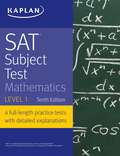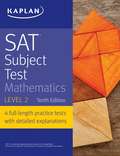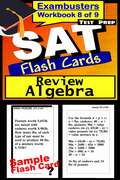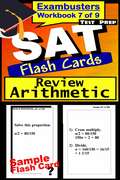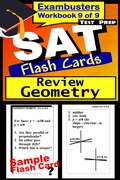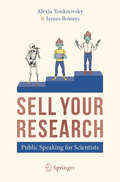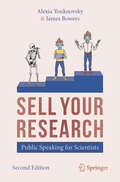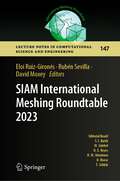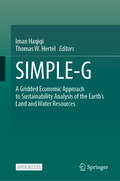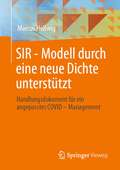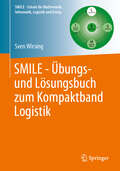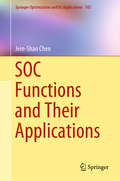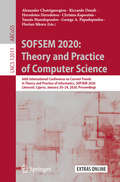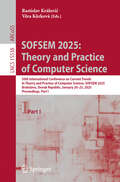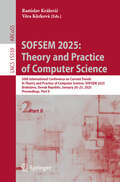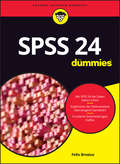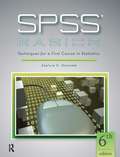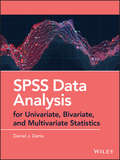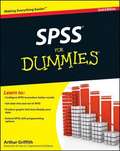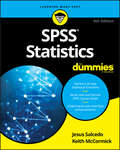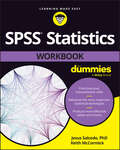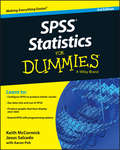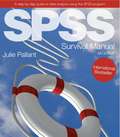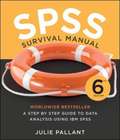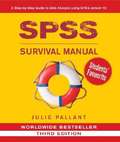- Table View
- List View
SAT Subject Test Mathematics Level 1
by KaplanEssential strategies, practice, and review to ace the SAT Subject Test Mathematics Level 1 Getting into a top college has never been more difficult. Students need to distinguish themselves from the crowd, and scoring well on an SAT Subject Test gives students a competitive edge. Kaplan’s SAT Subject Test Mathematics Level 1 is the most up-to-date guide on the market with complete coverage of both the content review and strategies students need for success on Test Day. Kaplan’s SAT Subject Test Mathematics Level 1 features: * A full-length diagnostic test * 4 full-length practice tests * Focused chapter summaries, highlights, and quizzes * Detailed answer explanations * Proven score-raising strategies * End-of-chapter quizzesKaplan is serious about raising students’ scores—we guarantee students will get a higher score, or get their money back.
SAT Subject Test Mathematics Level 2
by KaplanEssential strategies, practice, and review to ace the SAT Subject Test Mathematics Level 2 Getting into a top college has never been more difficult. Students need to distinguish themselves from the crowd, and scoring well on an SAT Subject Test gives students a competitive edge. Kaplan’s SAT Subject Test Mathematics Level 2 is the most up-to-date guide on the market with complete coverage of both the content review and strategies students need for success on Test Day. Kaplan’s SAT Subject Test Mathematics Level 2 features: * A full-length diagnostic test * 4 full-length practice tests * Focused chapter summaries, highlights, and quizzes * Detailed answer explanations * Proven score-raising strategies * End-of-chapter quizzesKaplan is serious about raising students’ scores—we guarantee students will get a higher score, or get their money back.
SAT Test Prep Flash Cards: Algebra Review (Exambusters SAT Workbook #8 of 9)
by Ace Inc.<P><P><i>Advisory: Bookshare has learned that this book offers only partial accessibility. We have kept it in the collection because it is useful for some of our members. Benetech is actively working on projects to improve accessibility issues such as these.</i><P><P> 450 questions and answers that highlight introductory algebra definitions, problems, and concepts. <P><P>Topics: Algebraic Concepts, Sets, Variables, Exponents, Properties of Numbers, Simple Equations, Signed Numbers, Monomials, Polynomials, Additive and Multiplicative Inverse, Word Problems, Prime Numbers, Factoring, Algebraic Fractions, Ratio and Proportion, Variation, Radicals, Quadratic Equations <P>EXAMBUSTERS SAT Prep Workbooks provide comprehensive, fundamental SAT review--one fact at a time--to prepare students to take practice SAT tests. Each SAT study guide focuses on one specific subject area covered on the SAT exam. From 300 to 600 questions and answers, each volume in the SAT series is a quick and easy, focused read. Reviewing SAT flash cards is the first step toward more confident SAT preparation and ultimately, higher SAT exam scores!
SAT Test Prep Flash Cards: Arithmetic Review (Exambusters SAT Workbook #7 of 9)
by Ace Inc.P><P><i>Advisory: Bookshare has learned that this book offers only partial accessibility. We have kept it in the collection because it is useful for some of our members. Benetech is actively working on projects to improve accessibility issues such as these.</i><P><P> 600 questions and answers highlight essential arithmetic definitions, problems, and concepts. <P><P>Topics: Addition, Subtraction, Multiplication, and Division of Whole Numbers; Fractions and Decimals, Multiplication Tables, Word Problems, Percents, Measurement, Metric System, Square Roots and Powers, Real Numbers, Properties of Numbers <P> EXAMBUSTERS SAT Prep Workbooks provide comprehensive, fundamental SAT review--one fact at a time--to prepare students to take practice SAT tests. Each SAT study guide focuses on one specific subject area covered on the SAT exam. From 300 to 600 questions and answers, each volume in the SAT series is a quick and easy, focused read. Reviewing SAT flash cards is the first step toward more confident SAT preparation and ultimately, higher SAT exam scores!
SAT Test Prep Flash Cards: Geometry Review (Exambusters SAT Workbook #9 of 9)
by Ace Inc.<P><P><i>Advisory: Bookshare has learned that this book offers only partial accessibility. We have kept it in the collection because it is useful for some of our members. Benetech is actively working on projects to improve accessibility issues such as these.</i><P><P> 450 questions and answers that focus on essential geometry theorems, postulates, concepts, and definitions. Includes complementary diagrams. <P><P>Topics: Lines and Angles, Triangles, Proofs, Perpendicular Lines, Parallel Lines, Angle Sums, Quadrilaterals, Medians, Altitudes and Bisectors, Circles, Ratio and Proportion, Similar Polygons, Circles and Regular Polygons, Coordinate Geometry<P> EXAMBUSTERS SAT Prep Workbooks provide comprehensive, fundamental SAT review--one fact at a time--to prepare students to take practice SAT tests. Each SAT study guide focuses on one specific subject area covered on the SAT exam. From 300 to 600 questions and answers, each volume in the SAT series is a quick and easy, focused read. Reviewing SAT flash cards is the first step toward more confident SAT preparation and ultimately, higher SAT exam scores!
SELL YOUR RESEARCH: Public Speaking for Scientists
by Alexia Youknovsky James BowersPublic speaking is an essential component in the life of a scientist, whatever your level of career. In this book, the authors describe a tried-and-tested technique for preparing a presentation: the SELL Method. Following these three simple steps - Skeleton, Envelope, Life & Logistics - will help you make the most out of any talk. Whether it be a 3-minute pitch or an hour-long plenary session, you will find pages of advice, theory and practical exercises enabling you to SELL YOUR RESEARCH with impact.For scientists these days, the work is not done until it is communicated. And now that problem is solved. Solidly researched and immaculately written, Sell Your Research is a goldmine of useful advice. Whether you are brimming with confidence or just setting out, this gem of a guidebook will improve every presentation and nurture every budding science communicator.Dr. Stephen Webster, Director of Science Communication Unit, Imperial College LondonPublic speaking is one of the most intimidating but crucial tasks in a scientist’s career. This book provides a welcoming, clear, step-by-step guide to improving your presentations at every level. Reading it and following its advice will make your science talks less frightening and more enjoyable. Dr. Laura Helmuth, Health, Science & Environment Editor, Washington Post
SELL YOUR RESEARCH: Public Speaking for Scientists
by Alexia Youknovsky James BowersPublic speaking is an essential component in the life of a scientist, whatever your level of career. In this book, the authors describe a tried-and-tested technique for preparing a presentation: the SELL method. Following these three simple steps—Skeleton, Envelope, and Life and Logistics—will help you make the most out of any talk. Whether it be a 3-minute pitch or an hour-long plenary session, you will find pages of advice, theory, and practical exercises enabling you to Sell Your Research with impact. This second edition is enriched with new insights in storytelling, online presenting, and speaking with the media on hot topics. For scientists these days, the work is not done until it is communicated. And now that problem is solved. Solidly researched and immaculately written, Sell Your Research is a goldmine of useful advice. Whether you are brimming with confidence or just setting out, this gem of a guidebook will improve every presentation and nurture every budding science communicator. Dr. Stephen Webster, former Director of Science Communication Unit, Imperial College London Public speaking is one of the most intimidating but crucial tasks in a scientist’s career. This book provides a welcoming, clear, step-by-step guide to improving your presentations at every level. Reading it and following its advice will make your science talks less frightening and more enjoyable. Dr. Laura Helmuth, Editor In Chief, Scientific American
SIAM International Meshing Roundtable 2023 (Lecture Notes in Computational Science and Engineering #147)
by David Moxey Rubén Sevilla Eloi Ruiz-GironésThis volume comprises selected papers from the SIAM International Meshing Roundtable Workshop 2023, SIAM IMR 2023, held in Amsterdam, the Netherlands, March 6-9, 2023. The IMR was started by Sandia National Laboratories in 1992 and, since 2021, it has been held under the umbrella of the Society for Industrial and Applied Mathematics (SIAM). The SIAM IMR 2023 was the first in-situ conference to be held since 2019, after two online conferences. It consisted of short courses, technical presentations from keynotes, contributed talks and research notes, a poster session and meshing contest, and discussion panels. The papers in these proceedings present novel contributions that range from theoretical advances to technical applications in engineering, geometric modeling, computer graphics, visualization, and machine learning.
SIMPLE-G: A Gridded Economic Approach to Sustainability Analysis of the Earth’s Land and Water Resources
by Thomas W. Hertel Iman HaqiqiThis is an open access book. Crafted for both the economist and the curious mind, this book introduces a novel approach to blending economic and biophysical sciences to enable multi-scale analysis of a range of sustainability challenges confronting the world’s land and water resources at both local and global scales. It focuses specifically on the interface between the environment and food systems, utilizing economic theory to structure the overall framework. However, within the SIMPLE-G framework, there is ample room to incorporate fine-scale biophysical knowledge from agronomy, climate science, ecology, geography, hydrology, as well as a range of socioeconomic considerations. This enables multi-scale analyses incorporating grid cells that can vary in size from 250 meters to sub-regional scales. This, in turn, allows for investigation of global change drivers’ impacts on local sustainability, as well as feedbacks from local sustainability policies to regional and global outcomes. The book opens with a foreword by a prominent sustainability scientist, Prof. Navin Ramankutty, and proceeds in five parts covering, respectively: (1) introduction and overview, (2) basic economic theory underpinning SIMPLE-G, (3) the SIMPLE-G framework, including structure, data, parameters, computer implementation, and validation, (4) eight diverse applications of the SIMPLE-G framework, covering a range of geographies and sustainability challenges, and (5) a forward-looking chapter on future directions. The book provides step-by-step guidance on building and utilizing gridded models with real-world case studies demonstrating practical applications which will facilitate its use by academics, practitioners, and students conducting research on climate impacts, land-use, water resource management, food security, poverty, equity, nutritional outcomes, and overall sustainability.
SIR - Modell durch eine neue Dichte unterstützt: Handlungsdokument für ein angepasstes COVID – Management
by Marcus HellwigDas durch eine neue Dichte unterstützte SIR – Modell und dessen Derivate erhalten einen statistischen Datenhintergrund aus Häufigkeitsverteilungen, aus deren Parameterwerten über die neue Dichteverteilung auf eine qualitätsorientierte Wahrscheinlichkeit des jeweiligen Infektionsprozesses und seiner Zukunft geschlossen werden kann. Dadurch erhält das COVID - Management eine funktionsgemäße modellhafte Grundlage zur vorbeugenden Steuerung der Komponenten Zeitplanung, Kostenentwicklung, Qualitätsmanagement und Personal- und Materialeinsatz.
SMILE - Übungs- und Lösungsbuch zum Kompaktband Logistik (Schule für Mathematik, Informatik, Logistik und Erfolg)
by Sven WirsingDieses Übungsbuch ergänzt den SMILE-Kompaktband mit einer Vielzahl von Übungsaufgaben und deren Lösungen. Alle im Kompaktband dargestellten Inhalte: Grundlagen, Wareneingangskontrolle, Chargenschnittstelle, Kühlguteinlagerung, GUI-Dialoge und Disposition von LKWs werden mit logistischen und mathematischen Aufgaben sowie Fragestellungen zu Python vertieft. Die Python-Lösungen sind bei Springer downloadbar. Ein besonderes Highlight ist das letzte Kapitel Szenario „Tischtennis-AG“, in dem mittels einer fiktiven Firma, die Tischtennis-AG, die wichtigsten Thematiken zu allen Kapiteln erneut als Aufgaben praxisrelevant dargestellt werden.
SOC Functions and Their Applications (Springer Optimization and Its Applications #143)
by Jein-Shan ChenThis book covers all of the concepts required to tackle second-order cone programs (SOCPs), in order to provide the reader a complete picture of SOC functions and their applications. SOCPs have attracted considerable attention, due to their wide range of applications in engineering, data science, and finance. To deal with this special group of optimization problems involving second-order cones (SOCs), we most often need to employ the following crucial concepts: (i) spectral decomposition associated with SOCs, (ii) analysis of SOC functions, and (iii) SOC-convexity and -monotonicity. <p><p> Moreover, we can roughly classify the related algorithms into two categories. One category includes traditional algorithms that do not use complementarity functions. Here, SOC-convexity and SOC-monotonicity play a key role. In contrast, complementarity functions are employed for the other category. In this context, complementarity functions are closely related to SOC functions; consequently, the analysis of SOC functions can help with these algorithms.
SOFSEM 2020: 46th International Conference on Current Trends in Theory and Practice of Informatics, SOFSEM 2020, Limassol, Cyprus, January 20–24, 2020, Proceedings (Lecture Notes in Computer Science #12011)
by Yannis Manolopoulos Riccardo Dondi George A. Papadopoulos Alexander Chatzigeorgiou Herodotos Herodotou Christos Kapoutsis Florian SikoraThis book constitutes the refereed proceedings of the 46th International Conference on Current Trends in Theory and Practice of Informatics, SOFSEM 2020, held in Limassol, Cyprus, in January 2020. The 40 full papers presented together with 17 short papers and 3 invited papers were carefully reviewed and selected from 125 submissions. They presented new research results in the theory and practice of computer science in the each sub-area of SOFSEM 2020: foundations of computer science, foundations of data science and engineering, foundations of software engineering, and foundations of algorithmic computational biology.
SOFSEM 2025: 50th International Conference on Current Trends in Theory and Practice of Computer Science, SOFSEM 2025, Bratislava, Slovak Republic, January 20–23, 2025, Proceedings, Part I (Lecture Notes in Computer Science #15538)
by Věra Kůrková Rastislav KrálovičThis book constitutes the proceedings of the 50th International Conference on Current Trends in Theory and Practice of Computer Science, SOFSEM 2025, held in Bratislava, Slovak Republic, during January 20-23, 2025. The 48 full papers presented in this book were carefully reviewed and selected from 109 submissions. They include original research from all areas of foundations of computer science and artificial intelligence focusing on AI-based algorithms and techniques, nature-inspired computing, machine learning theory, multi-agent algorithms and games, neural network theory, parallel and distributed computing, quantum computing, computability, decidability, classical and non-classical models of computation, computational complexity, computational learning, cryptographic techniques and security, data compression, data and pattern mining methods, discrete combinatorial optimization, automata, languages, machine models, rewriting systems, efficient data structures, graph structure and algorithms, logics of computation, robotics, and other relevant theory topics in computing and AI.
SOFSEM 2025: 50th International Conference on Current Trends in Theory and Practice of Computer Science, SOFSEM 2025, Bratislava, Slovak Republic, January 20–23, 2025, Proceedings, Part II (Lecture Notes in Computer Science #15539)
by Věra Kůrková Rastislav KrálovičThis book constitutes the proceedings of the 50th International Conference on Current Trends in Theory and Practice of Computer Science, SOFSEM 2025, held in Bratislava, Slovak Republic, during January 20-23, 2025. The 48 full papers presented in this book were carefully reviewed and selected from 109 submissions. They include original research from all areas of foundations of computer science and artificial intelligence focusing on AI-based algorithms and techniques, nature-inspired computing, machine learning theory, multi-agent algorithms and games, neural network theory, parallel and distributed computing, quantum computing, computability, decidability, classical and non-classical models of computation, computational complexity, computational learning, cryptographic techniques and security, data compression, data and pattern mining methods, discrete combinatorial optimization, automata, languages, machine models, rewriting systems, efficient data structures, graph structure and algorithms, logics of computation, robotics, and other relevant theory topics in computing and AI.
SPSS 24 für Dummies (Für Dummies)
by Felix BrosiusOb Kundendaten oder Absatzzahlen, Umfrageergebnisse oder wissenschaftliche Studien - große Datenmengen lassen sich am besten mit SPSS untersuchen, dem am häufigsten eingesetzten Softwaretool zur statistischen Datenanalyse. Mit "SPSS 24 für Dummies" erhalten Sie eine unterhaltsam geschriebene und zugleich sehr fundierte Einführung in dieses mächtige Programm. Werten Sie Daten professionell aus, kommen Sie auf dieser Basis zu belastbaren Ergebnissen, die Grundlage für Ihre Entscheidungen sein können, und machen Sie so umfangreiche Datenmengen zu wichtigen Informationsquellen.
SPSS Basics: Techniques for a First Course in Statistics
by Zealure C. HolcombThis text takes the guesswork out of using SPSS, with screenshots that show each step for calculating each statistic. It includes extensive coverage of how to format raw SPSS output for inclusion in research reports. End-of-chapter exercises help students master their newly acquired skills. An instructor's answer key will be included with each complimentary examination copy. New to this edition: This edition includes an abundance of instructional screenshots, all of which have been updated to reflect the new look of IBM SPSS Statistics Version 23. Instructor ancillaries that accompany this text include PowerPoints for classroom instruction, and test banks in text format and importable to Respondus.
SPSS Data Analysis for Univariate, Bivariate, and Multivariate Statistics
by Daniel J. DenisEnables readers to start doing actual data analysis fast for a truly hands-on learning experience This concise and very easy-to-use primer introduces readers to a host of computational tools useful for making sense out of data, whether that data come from the social, behavioral, or natural sciences. The book places great emphasis on both data analysis and drawing conclusions from empirical observations. It also provides formulas where needed in many places, while always remaining focused on concepts rather than mathematical abstraction. SPSS Data Analysis for Univariate, Bivariate, and Multivariate Statistics offers a variety of popular statistical analyses and data management tasks using SPSS that readers can immediately apply as needed for their own research, and emphasizes many helpful computational tools used in the discovery of empirical patterns. The book begins with a review of essential statistical principles before introducing readers to SPSS. The book then goes on to offer chapters on: Exploratory Data Analysis, Basic Statistics, and Visual Displays; Data Management in SPSS; Inferential Tests on Correlations, Counts, and Means; Power Analysis and Estimating Sample Size; Analysis of Variance – Fixed and Random Effects; Repeated Measures ANOVA; Simple and Multiple Linear Regression; Logistic Regression; Multivariate Analysis of Variance (MANOVA) and Discriminant Analysis; Principal Components Analysis; Exploratory Factor Analysis; and Non-Parametric Tests. This helpful resource allows readers to: Understand data analysis in practice rather than delving too deeply into abstract mathematical concepts Make use of computational tools used by data analysis professionals. Focus on real-world application to apply concepts from the book to actual research Assuming only minimal, prior knowledge of statistics, SPSS Data Analysis for Univariate, Bivariate, and Multivariate Statistics is an excellent “how-to” book for undergraduate and graduate students alike. This book is also a welcome resource for researchers and professionals who require a quick, go-to source for performing essential statistical analyses and data management tasks.
SPSS For Dummies, 2nd Edtion
by Arthur GriffithThe fun and friendly guide to the world's leading statistical software Predictive Analysis Software (PASW), formerly SPSS software, is the leading statistical software used by commerical, government, and academic organizations around the world to solve business and research problems. It allows you to quickly and easily discover new insights from data, test hypotheses, and build powerful predictive models. PASW Statistics For Dummies covers everything you need to know to get up and running with this efficient and practical software. PASW Statistics is the leading statistical software used to analyze data and create predictive models; it is used by business, academic, and government entities worldwide This guide explains how to work with automatic codebook generation and customize the variable view Walks you through the rounding method that is used in all calculations and explains using predictive analysis Shows how to maximize your use of graph templates, and much more Even if you have little or no statistical or mathematical background, PASW Statistics For Dummies will show you how to generate statistical support and decision-making information quickly and easily. Note: CD-ROM/DVD and other supplementary materials are not included as part of eBook file.
SPSS Statistics For Dummies
by Jesus Salcedo Keith McCormickThe fun and friendly guide to mastering IBM’s Statistical Package for the Social Sciences Written by an author team with a combined 45 years of experience using SPSS, this updated guide takes the guesswork out of the subject and helps you get the most out of using the leader in predictive analysis. Covering the latest release and updates to SPSS 25.0, and including over 100 pages of basic statistical theory, it helps you understand the mechanics behind the calculations, perform predictive analysis, produce informative graphs, and more. You’ll even dabble in programming as you expand SPSS functionality to suit your specific needs. Master the fundamental mechanics of SPSS Learn how to get data into and out of the program Graph and analyze your data more accurately and efficiently Program SPSS with Command Syntax, Python, and scripts Get ready to start handling data like a pro—with step-by-step instruction and expert advice!
SPSS Statistics Workbook For Dummies
by Jesus Salcedo Keith McCormickPractice making sense of data with IBM’s SPSS Statistics software SPSS Statistics Workbook For Dummies gives you the practice you need to navigate the leading statistical software suite. Data management and analysis, advanced analytics, business intelligence—SPSS is a powerhouse of a research platform, and this book helps you master the fundamentals and analyze data more effectively. You’ll work through practice problems that help you understand the calculations you need to perform, complete predictive analyses, and produce informative graphs. This workbook gives you hands-on exercises to hone your statistical analysis skills with SPSS Statistics 28. Plus, explanations and insider tips help you navigate the software with ease. Practical and easy-to-understand, in classic Dummies style. Practice organizing, analyzing, and graphing data Learn to write, edit, and format SPSS syntax Explore the upgrades and features new to SPSS 28 Try your hand at advanced data analysis proceduresFor academics using SPSS for research, business analysts and market researchers looking to extract valuable insights from data, and anyone with a hankering for more stats practice.
SPSS Statistics for Dummies
by Keith Mccormick Jesus Salcedo Aaron Pohdata, and this book is your beginner-friendly guide to getting the most out of the software.Master the fundamental mechanics of SPSSLearn how to get data into and out of the programGraph and analyze your data more accurately and efficientlyStatistical analysis is crucial to so many industries, and accuracy and efficiency are crucial. SPSS offers you the capability to deliver, but you still must know how to take utmost advantage of the tools at your fingertips. SPSS For Dummies shows you how to handle data like a pro, with step-by-step instruction and expert advice.
SPSS Survival Manual
by Julie PallantThis guide book provides a reference source to enable students not only to navigate but understand statistical analysis performed in and output produced by SPSS.
SPSS Survival Manual: A Step By Step Guide to Data Analysis Using IBM SPSS
by Julie PallantThe SPSS Survival Manual throws a lifeline to students and researchers grappling with this powerful data analysis software. In her bestselling guide, Julie Pallant guides you through the entire research process, helping you choose the right data analysis technique for your project. From the formulation of research questions, to the design of the study and analysis of data, to reporting the results, Julie discusses basic and advanced statistical techniques. She outlines each technique clearly, with step- by-step procedures for performing the analysis, a detailed guide to interpreting data output and an example of how to present the results in a report. For both beginners and experienced users in psychology, sociology, health sciences, medicine, education, business and related disciplines, the SPSS Survival Manual is an essential text. Illustrated with screen grabs, examples of output and tips, it is supported by a website with sample data and guidelines on report writing. This sixth edition is fully revised and updated to accommodate changes to IBM SPSS procedures, screens and output. It covers new SPSS tools for generating graphs and non-parametric statistics, importing data, and calculating dates.
SPSS Survival Manual: A Step By Step Guide to Data Analysis Using SPSS for Windows
by Julie PallantIn this fully revised edition of her bestselling text, Julie Pallant guides you through the entire research process, helping you choose the right data analysis technique for your project. From the formulation of research questions, to the design of the study and analysis of data, to reporting the results, Julie discusses basic and advanced statistical techniques. She outlines each technique clearly, with step-by-step procedures for performing the analysis, a detailed guide to interpreting SPSS output and an example of how to present the results in a report. For both beginners and experienced SPSS users in psychology, sociology, health sciences, medicine, education, business and related disciplines, the SPSS Survival Manual is an essential guide. Illustrated with screen grabs, examples of output and tips, it is supported by a website with sample data and guidelines on report writing. In this third edition all chapters have been updated to accommodate changes to SPSS procedures, screens and output in version 15. A new flowchart is included for SPSS procedures, and factor analysis procedures have been streamlined. It also includes more examples and material on syntax. Additional data files are available on the book's supporting website.
